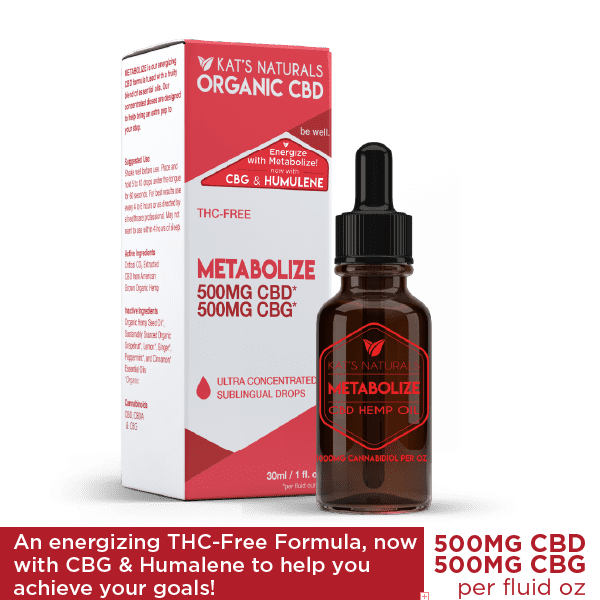No products in the cart.
CBG Benefits: A 101 Guide to What It Is, How It Works, and Why to Use It
When congress legalized hemp with the 2018 Farm Bill, CBD became a trending topic. Well-known brands, major retailers, and new startups began to sell CBD products. And as the market flooded, consumers started to hear more about the famous cannabinoid. But there is a new chemical compound in the hemp plant that’s garnering attention, and its popularity is mimicking that of CBD. It’s called CBG.
CBG stands for cannabigerol, and it’s quickly becoming the next big cannabinoid as brands start to study and discover its benefits. The U.S. government is keen to learn about the chemical compound. In 2018, The National Center for Complementary and Integrative Health (NCCIH) announced that they intended to study various cannabinoids, including CBG, to see if it could help relieve and manage pain.
But while research on the cannabinoid’s benefits is still in its infancy, brands are including the nutrient in their products. CBG holds so much potential, and as demand for CBG oil skyrockets, the price increases as well.
Dubbed as the “Rolls Royce of cannabinoids,” CBG costs $35,000 for one kilo in 2019. That price mirrors what CBD costs when it hit the market in 2016. However, just like the price of CBD decreased and evened out once it was easier to get, the price of CBG has already dropped by half its initial amount. But until it becomes even more accessible, brands are willing to pay a hefty price to get a hold of the phytocannabinoid and take advantage of the new niche.
What is CBG, and how does it work?
Researchers first discovered CBG in the 1960s and consider it the mother of all cannabinoids. It’s the first one to form in the cannabis plant. The phytonutrient also converts to other cannabinoids such as THC, CBD, and CBC depending on how the plant’s chemical makeup breaks down when it matures.
When consumers ingest the cannabinoid, CBG does the same thing as other phytocannabinoids. It interacts with the endocannabinoid system (ECS). However, CBG does so a little bit differently. A team of researchers discovered the endocannabinoid system in the 1990s and defined it as a complex network that’s responsible for regulating essential processes in the body, including sleep, mood, memory, appetite, reproduction, and fertility.
Every human and vertebrate has an endocannabinoid system, and every endocannabinoid system has cannabinoid receptors and endogenous cannabinoids. The main two receptors in this complex network are CB1 and CB2 receptors.
CB1 receptors are primarily in the central nervous system, and CB2 receptors are mostly in the peripheral nervous system. In addition, one of the most prominent endogenous cannabinoids is called anandamide. It’s a compound that helps ensure the body functions effectively.
When CBG interacts with the endocannabinoid system, it acts on both CB1 and CB2 receptors, making it slightly different than CBD, which only responds to CB2 receptors. However, one commonality between CBD and CBG is that they both antagonize anandamide to help it function better.
What are CBG’s benefits?
While researchers are still exploring the benefits of CBG, several studies suggest a few different ways the cannabinoid can provide therapeutic advantages.
1. CBG benefits the body
A study conducted in 2008 suggests that CBG is an antibacterial agent. As such, it can help treat Methicillin-Resistant Staphylococcus Aureus (MRSA), a specific type of staph infection that can’t be managed by common antibiotics such as methicillin.
Because MRSA doesn’t respond to typical treatments, it’s a threatening and potentially fatal bacterial infection. But, with CBG, people could find relief because of the cannabinoid’s antibacterial properties.
2. CBG benefits the digestive system
Studies indicate that CBG can help with digestive medical conditions such as colitis and inflammatory bowel disease (IBD). In 2013, researchers studied rats to see if CBG was an effective treatment for colitis.
They concluded that the cannabinoid successfully reduced the effect of the ailment. The study also found that IBD patients experienced relief from their symptoms with the use of cannabis. Still, the researchers need to study the cannabinoid in isolation to see if it can work on its own.
3. CBG benefits the skin
Researchers have also found that CBG mitigates skin conditions like psoriasis, a chronic immune-mediated disease that’s believed to affect more than 125 million people around the world. The symptoms of this condition include thick, extensive skin lesions that lead to itching, scaling, and pain. Researchers believe CBG can ease the symptoms of psoriasis, but research is still ongoing.
More studies also need to explore whether the cannabinoid can increase energy and mental clarity, two benefits that people are noticing. While researchers have yet to dive into these claims, it’s likely that future studies will focus on these potential benefits as CBG becomes more popular.
What’s the best CBG dosage?
If people want to use CBG for its therapeutic relief, they might be wondering how much to take. The best practice for introducing anything new to a daily routine is to start slow and work up.
For CBG oil, in particular, start with three drops per dose and add one drop every other day to achieve the desired results. In addition, take into consideration the other cannabinoids that are in the product. Based on the other nutrients in the remedy, a person might need very little or a lot more of the cannabinoid to feel its effect.
Brands and researchers still have to conduct studies to determine the proper dosage of CBG. But for anyone who wants to use CBG for its potential benefits, the person should focus on testing which dosages work best for their body until more definitive answers and research arises.
Should consumers take CBG as an isolate?
Another thing people might wonder is whether they should take CBG as an isolate. There are reasons to take the cannabinoid as an isolate, but there are also reasons to use full or broad-spectrum products that contain the cannabinoid.
If people use it as an isolate, they can receive a consistent dose of CBG in every single batch. However, with a full-plant extract, the amount of CBG is somewhat limited because it decreases when the plant metabolizes.
This fact doesn’t mean that full or broad-spectrum products aren’t worth buying. On the contrary, when CBG combines with other cannabinoids, the blend leads to the entourage effect and targets different conditions.
Researchers need to do more work
CBG is on a long list of other phytocannabinoids that researchers and brands need to study. But as it continues to gain traction, more studies around the cannabinoid’s possible benefits will surface. While it might take time to get conclusive answers, the industry will not stop diving into the cannabinoid, especially since researchers believe CBG is helpful in multiple areas of life.





